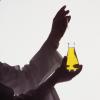最近給研究院準備了兩份精簡的,介紹我的工作的材料:一份是的讀者是社會上的“外行”,希望增進他們對研究院研究員們工作的了解,得到他們的贊助;另一份的讀者是研究院專家委員的成員,向他們介紹我的工作和最近的成果。
以前也寫過幾篇博文強調把自己的工作講解清楚的重要性,不論是對外行還是內行,都需要能在三五分鐘內講明白。我認為在這上面多花點時間,比寫論文還重要。
比如前兩天我在Illumina做介紹,因為他們說對iCubate和iRepertoire兩
個公司都感興趣,所以我從新組織了一下幻燈片,加在一起有95張之多,可是會議結束后得到的一個評論“Very impressive presentation,
did not feel you had so many slides at all",
因為我的幻燈片里面絕大多數都是圖片和提醒我要講的內容的幾個關鍵詞,沒有很“忙”的,充滿文字的幻燈片。這樣聽眾就不會覺得很累。
一個常見的演講錯誤就是演講者把要講的內容都放到幻燈片上去了,這樣就要求聽講者又是閱讀(幻燈片),又是要聽講。最后兩件事情都沒有做好。
另外,講解要把廢話全都剔除出去,越精簡越好,演講時的語氣,速度都有講究,不能太單調,催人入睡。
做科學和技術創新,我們不單單要強調在實驗室和文獻堆里面的本領,還要強調實驗室以外的和同行,投資者等的交流能力。要進得了實驗室,上得了演講臺,還要能在雞尾酒會上把自己做的科學項目講成動聽的故事。這樣別人才能感染到你的激情,才能更關注,更支持你的工作。
分析化學 儀器分析 紅外光譜
如果在講到自己的工作的時候沒有激情,那你真的很愛你的工作嗎?
附件(1)是給社會人士看的:
INFECTIOUS DISEASE
HudsonAlpha is working to improve healthcare quality, while
lowering healthcare costs.
FACT
Pathogens (bacteria, viruses, and protozoans) must be
accurately detected for proper diagnosis and treatment of infectious
diseases.
WE KNOW
Each pathogenic microorganism or virus has a unique DNA
fingerprint.
The Polymerase Chain Reaction (PCR) can detect DNA from
microorganisms or viruses with great sensitivity.
PCR assays for many pathogens may be combined together
(multiplexed), so that only one clinical sample is needed to identify the actual
pathogen from a broad spectrum of possibilities.
BACKGROUND
For the USA alone, the cost of treatment and lost productivity
associated with illness from infectious disease is more than $120 billion each
year.
PROBLEM
PCR multiplexing is easy in theory, but difficult in
practice—especially in a clinical setting—so that few multiplex tests are
available.
Existing PCR-based diagnostic tests require manual
intervention and are therefore slow, costly, and sometimes unreliable because of
operator error.
Diagnostic tests are currently performed in an open
environment, with an unacceptable risk of sample contamination.
TASKS
Develop more robust multiplex PCR assays.
The proprietary ARM-PCR technology (Amplicon Rescued Multiplex
PCR) allows up to 30 different DNA targets to be reliably amplified in one
reaction.
Develop an automated and closed system for PCR diagnostic
tests.
The fully automated iCubate robotic system is fast (taking
less than two hours from sample loading to diagnosis), inexpensive per test, and
reliable. Samples are contained within a disposable, factory-sealed cassette,
making sample contamination or cross-contamination virtually
impossible.
The HudsonAlpha company iCubate is launching the iCubate
system in 2010, which promises improved diagnosis for infectious diseases at
lower cost.
**************
附件(2)給專家委員會看的簡介:
One core technology, two key applications, and two commercial
opportunities
Background
Dr. Jian Han invented a multiplex PCR method called amplicon
rescued multiplex PCR (arm-PCR). The patent pending method allows hundreds of
thousands of molecular targets to be amplified from one reaction, in a
semi-quantitative fashion.
Dr. Han and his group have identified two major applications
for the technology: (1) Molecular differential diagnosis of infectious diseases
and cancers; and (2) Immune repertoire analysis by arm-PCR amplification
followed by high throughput sequencing.
As a serial entrepreneur, Dr. Han formed two companies to
fully capture the commercial opportunities: iCubate Inc., (www.iCubate.com) is a
biotech company developing assays and instrument platforms for molecular
differential diagnosis. iRepertoire Inc., (www.iRepertoire.com) is a company
developing technology for high throughput sequencing of immune
repertoires.
Updates
Molecular differential diagnosis.
Dr. Han raised $4.3 million from investors and obtained
exclusive license of the arm-PCR to form. iCubate. His team of scientists and
engineers developed the prototype iCubate system that include a processor, a
reader and software that control the instrument and providing an user
interface.
The system can automatically perform. DNA/RNA extraction,
multiplex amplification and detection , and do so in a closed, disposable
cassette. iCubate has already submitted a pre-IDE to FDA in order to prove their
Staph-DR product. The product will allow rapid identification of Staph.
including MRSA (methicillin-resistant Staphylococcus aureus), and also detecting
many resistance genes, allowing physicians to optimize the treatment strategy. A
pipeline of additional products for different infectious diseases are under
development.
There are multiple patents filed to protect the technologies,
including patent to protect the arm-PCR core technology and patents protect the
cassette, the processor and the readers. Other IP include copy rights for the
software and logo etc., as well as patents for sample preparations.
iCubate is raising $10 million USD for scale up manufacture of
the instrument, and conducting clinical trails for FDA approval. Since the
depute of the platform. last Nov at the AMP meeting (molecular pathology), all
major diagnostic companies (such as Abbott, Roche, Norvartis, and bioMerieux
etc) had already contacted iCubate and invited Dr. Han to present the technology
to high level executives.
Immune repertoire sequencing.
The first paper describing the use of arm-PCR/NextGen
sequencing approach was published on PNAS earlier this year:
Wang C, Sanders CM, Yang Q, Schroeder HW Jr. Wang E, Babrzadeh
F, Gharizadeh B, Myers RM, Hudson JR Jr. Davis RW, Han J. High throughput
sequencing reveals a complex pattern of dynamic interrelationships among human T
cells subsets. PNAS 2010 Jan 26; 107(4):1518-23.
A company, iRepertoire Inc., was formed to explore the
commercial opportunity of this technology. Based on the method describe in the
PNAS paper, a line of products and services were developed that allow scientists
worldwide to have access to the technology. Human and mouse T and B cells can be
used, sorted or not, for VDJ amplifications and sequenced with either Roche 454
or Illumina Solexa platforms. Barcoded primers allow upto 20 samples pooled for
one sequencing run. A sequence known library is also available for aiding
technology development and validation.
Several patents were filed protecting immune repertoire
amplification and data analysis. Also, a patent is filled to protect a unique
way to amplify B cell VDJs that overcome the impact of
hypermutations.
Dr. Han’s group have already studied the immune repertoire of
many samples, including samples from 10 breast cancer patients, 10 colon cancer
patients, 10 lung cancer patients, 20 CLL patients, and 10 lupus patients. These
studies will help identify signature immune repertoire changes that could be
used as biomarkers for future studies. In addition, we have completed an
extensive study post vaccine repertoire changes in two volunteers. More high
quality publications are expected within this year.
Future Directions


